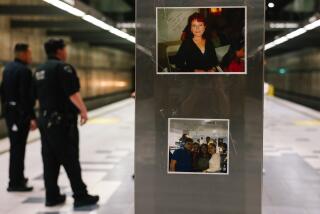Uberâs report on sexual assaults and accidents offers some answers, more questions

With the publication this week of its first safety transparency report, Uber offers the clearest look yet into the dangers of its platform. But it also establishes a baseline from which the ride-hailing giant must improve.
Uberâs long-awaited safety disclosure took the form of an 84-page report, which reveals that in 2017 and 2018 there were 107 deaths during traffic accidents, nearly 6,000 total reports of sexual assault and 19 fatal physical assaults. The company committed to publishing this data in May 2018 in response to a series of sexual assault claims.
The report, which the company says took 21 months to compile and audit, is the first of its kind in the ride-hailing industry. Until now, Uber and its primary competitor, Lyft, have declined to provide a look at the numbers of assault or misconduct complaints. The company is calling on others to join in publishing such data, going as far as providing its methodology and committing to releasing updated numbers every two years.
Laying bare the vulnerabilities of a platform that once billed itself as the âsafest ride on the roadâ is a bold step for the company, which has recently begun incorporating more robust safety features. But the true test will be whether that new focus will manifest in a decline in the number assault or misconduct claims as well as overall driver safety in the next report.
The company says preliminary information shows a decrease in sexual assault complaints in the first half of 2019, but cautions that there may ultimately be an increase âindependent of the underlying frequency of occurrenceâ because of new reporting initiatives.
Uber has aggressively promoted its new commitment to safety, announcing new features at high-profile events.
That goes for riders and drivers. According to the report, âdrivers report assaults at roughly the same rate as riders across the five most serious categories of sexual assault.â
The numbers paint a grim picture. Of the close to 6,000 sexual assault claims in 2017 and 2018 combined, 464 were allegations of nonconsensual penetration or rape; the company recorded 587 reports of attempted rape. Over the two-year period there were 3,000 complaints of nonconsensual touching of a sexual body part.
In the report, Uber contrasts its figures with those of the New York transit system, saying police received 1,125 complaints of sex offenses in the same time period. While taxis might seem like a more obvious point of comparison, the company argues there is no other comparable national report in the transportation industry. Chief legal officer Tony West argues in the document that Uber canât be âimmune to societyâs most serious safety challenges, including sexual assault,â at its current scale of 4 million daily trips in the U.S. (By comparison, the New York City subway system recorded an average of 5.4 million weekday riders in 2018.)
The report emphasizes that these incidents are a small percentage of total rides, saying that only 0.0003% of all rides had claims of sexual assault, fatal car crash or fatal physical assault.
âAt such a large scale, Uberâs platform ultimately reflects the world in which we operate â both the good and the bad,â the report reads.
The San Francisco company has been the target of numerous sexual assault lawsuits since its early days, perhaps most notoriously for the rape of a passenger in India in 2014. The case caused outrage across the country, leading to Uber being temporarily banned from operating in Delhi. After being reinstated, the company introduced a panic button that allowed passengers to notify police if there was an issue during a ride and send trip details to five people.
It wasnât until 2018, a year after current Chief Executive Dara Khosrowshahi took over the company from co-founder Travis Kalanick, that Uber said it would expand its emergency button across the U.S. and globally. The announcement was part of the first suite of features Uber introduced under Khosrowshahi, as the company sought to signal a new commitment to safety.
The ride-hailing organization has since announced several additions to the app focused on providing support to both passengers and drivers during crises, including the ability to text local police departments, a four-digit pin verifying a passenger is in the right car, and an experiment that allows the company to record and review audio during a trip. Despite some privacy concerns, the company has also tested recording videos during rides in Texas â a feature long called for by Mike Bomberger, a partner at law firm Estey & Bomberger, which represents more than 100 ride-hailing sexual assault claimants in suits against Uber.
âWeâre pleased that Uber is now testing cameras in Texas,â he said in a statement. âThatâs the real solution to this problem â if drivers know theyâre being recorded they wonât rape and assault.â
Though the data â which were audited by the National Sexual Violence Resource Center â give the public a better idea of the realities of ride-hailing, itâs still hard to know exactly how many assaults occur on Uberâs platform. For one, the companyâs âsurvivor-centricâ approach to investigating and reviewing assault claims means the information is based on what the reporting party says happened.
âAs a result, it does not necessarily reflect the actual number of occurrences of critical safety incidents, nor does it signal the ultimate disposition of any particular case,â the report reads. Studies show that sexual assaults are severely underreported, with only about 230 of 1,000 cases being brought to the police, by one measure.
âItâs important to remember when reading this report that only 1 in 3 women report their sexual assault,â Bomberger said. âTherefore, the number of women who have been sexually assaulted is certainly much higher than reported here.â







